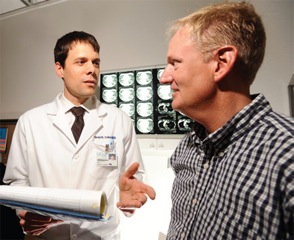Interstitial Lung Disease (ILD)
Interstitial lung diseases (ILD) are a large and diverse group of lung diseases that have similar clinical and pathologic findings, and symptoms. In interstitial lung disease, the lung tissue where the oxygen passes into the blood stream is inflamed and/or scarred, affecting the lung’s ability to provide the body with necessary amounts of oxygen.
What causes Interstitial Lung Disease?
There are many causes for inflammation and scarring (fibrosis) of lung tissue. Underlying connective tissue or autoimmune diseases such as rheumatoid arthritis, scleroderma, or myositis can cause inflammation of lung tissue. Some forms of interstitial lung diseases have a genetic cause and run in families. Inhalation of certain proteins, especially from feathers and molds, can also cause inflammation. If inflammation is present in the lung for a long time, scarring of the lung can occur. One of the most common types of interstitial lung disease, called idiopathic pulmonary fibrosis (IPF), is associated with aging and results in scarring of the lung rather than inflammation.
How is Interstitial Lung Disease Diagnosed?
 Because treatment depends on the specific ILD, an accurate diagnosis is extremely important. Diagnosis of ILD can be difficult and requires input from pulmonologists, radiologists, and in many cases, pathologists, experienced in the evaluation of patients with interstitial lung disease. A face-to-face discussion among experts in these different disciplines (a multidisciplinary case conference) is necessary to establish an accurate diagnosis.
Because treatment depends on the specific ILD, an accurate diagnosis is extremely important. Diagnosis of ILD can be difficult and requires input from pulmonologists, radiologists, and in many cases, pathologists, experienced in the evaluation of patients with interstitial lung disease. A face-to-face discussion among experts in these different disciplines (a multidisciplinary case conference) is necessary to establish an accurate diagnosis.
In making a diagnosis of ILD, your doctor will conduct a thorough history (medical, environmental, occupational, and family history), as well as a physical examination, including listening to your chest with a stethoscope, and carefully examining your skin and joints.
In addition, the following tests may be ordered to help make an accurate diagnosis:
- Pulmonary Function Testing (PFT).
- 6 Minute Walk Test (6MWT).
- High Resolution Computed Tomography (HRCT) of the chest.
- Blood analysis for autoantibodies, which may suggest presence of a connective tissue disease.
- Bronchoscopy with Bronchoalveolar lavage
- Video-Assisted Thoracoscopic Surgical Lung Biopsy (VATS biopsy).
Treatment
MEDICAL: As mentioned above, treatment depends on the type of interstitial lung disease. Anti-inflammatory or immunosuppressant medications may be recommended to reduce inflammation. It may be necessary to treat an underlying connective tissue disease or other contributory problem such as gastric reflux. If the ILD is thought to be due to an exposure to a protein, identification and removal of that antigen is essential. New antifibrotic therapies are available for for managing idiopathic pulmonary fibrosis. In addition we are involved in clinical trials testing novel treatments for pulmonary fibrosis.
EXERCISE: Most patients with interstitial lung disease benefit from engaging in a regular exercise program. This can be done independently or in a formal, structured, pulmonary rehabilitation program.
CLINICAL TRIALS: . Clinicians at UCSF are actively researching the causes and seeking to develop novel treatments for ILDs. Patients should discuss current opportunities with their doctor and consider participating in a clinical trial. For more information on clinical trials, please contact Alma Andrade.
ILD SUPPORT GROUP: Living Well with Interstitial Lung Disease: Patients with ILD meet at UCSF on a monthly basis to discuss personal experiences, and learn more about the causes and management of interstitial lung diseases. Contact Elida Oettel, LCSW for more information.
TO MAKE AN APPOINTMENT
To make an appointment, visit the Medical Center Website.
